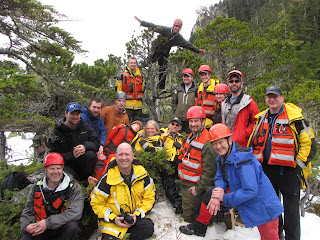Beachcombing is a fantastic activity, but it can be difficult to explain its appeal to those who don't practicioners. This is a description of a kayak trip to Peisar, in conjunction with a nice low tide that is a big help for getting around the beaches in search for anything and everything interesting.
Beachcombing starts with the premise that any object, dropped anywhere on Earth or placed in its orbit, will eventually find its way to the Ocean, and wash up on a beach somewhere. A classic example, of course, is that of fishing nets, such as this gillnet with old-fashioned flat floats:

Of course, when people think of beachcombing in Alaska, they usually think of Japanese glass floats, but those are rare here in Sitka these days, especially when compared with the Aleutian Islands for example. One reason is our rocky coastline:

And another is collectors. Modern Asian fishing floats are much more common than the old glass ones, because they are rock-proof, and rather ugly. The metal ones are usually Russian, and the plastic ones Japanese, Korean, Taiwanese, Chinese, etc., etc.

The problem with the modern fishing floats, is that they could have been used by anyone, and lost anywhere in the world, so they have in effect no story to tell. A good example is this float that was made in Denmark, but clearly didn't drift in from there:

Much more interesting, in my opinion, is trash. Trash is common, collector-proof, and often rock-proof too. It encompasses everything from baseball caps to refrigerators, and provides a fascinating view of the ocean. On my walk around Peisar Island Friday morning, I collected a few dozen Asian bottlecaps to demonstrate the worldliness of our plastic junk.
These are some Russian bottlecaps:

Here are some Japanese bottlecaps. "Pocari Sweat" is a particularly unpleasant brand of sport drink. This one had been chewed by a bear that apparently learned that sugar can occasionally be obtained from plastic bottles:

Now, some Korean bottlecaps:

And finally, an array of bottlecaps from China and / or Taiwan, and possibly a few Japanese ones mixed in there as well. While Chinese bottlecaps are amazingly plentiful on our beaches (much more so than American ones), it must be remembered that there are 1.1 billion people in China, and the amount of trash we get from them is more indicative of population level and current patterns, than of waste management policy.

I mentioned bears. Yes, bears are out and about on Peisar already!

And finally, all sorts of bones and dead critters can often be found on our beaches, from the worn-down lump of calcified material to the perfect sea otter skull. I was happy to come across this posterior half of a whale's skull, but also dismayed to find that wouldn't fit in my kayak:

Next up: a post on the slimy critters I found during that same walk.





















































